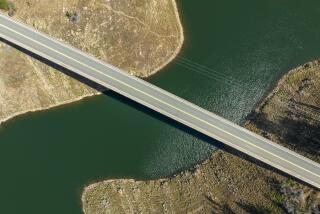Attitude Adjustment : Drought is dead, and so is the old thinking about water use
- Share via
Gov. Pete Wilson hit just the right rhetorical note last week when he announced the official end of California’s six-year-long dry spell: “Thanks to God for ending the drought, and thanks to the people of California for enduring it.”
Indeed, few residents of this region will deny that the end of one of the longest, costliest droughts in California’s recorded history was the result of forces more powerful than man. Whether one chooses to attribute this winter’s record rains and snowfall to the workings of a deity, Mother Nature or just luck, they came along just when we needed them. And 30-million-plus people from San Diego to Crescent City are grateful.
Of course, almost as many Californians were beginning to wonder whether Wilson or any other state official would ever acknowledge the fact that this winter’s many storms were at least making a dent in the dry spell. Many have criticized the state’s reluctance to officially admit that the drought was over, but the reluctance is understandable. State water officials understand far better than most people that California’s periodic water shortages are as much a structural problem as a weather problem.
As California’s population has continued to grow rapidly, it has been impossible for water engineers to keep up. There is simply not enough money, or in many instances political will, to construct massive dams and canals such as those that Californians used to build. Like the era of pell-mell freeway construction, those days are gone forever. And that’s not all bad, because we can now use our water resources and infrastructure far more efficiently.
Despite the fact that Californians have put up with six of the driest years this state has seen in this century, we did so without the bitter water wars that have marked state politics in the past. Rather than fighting over limited supplies, for example, Northern and Southern Californians looked for ways to use them more creatively. The most noteworthy instance is how both north and south prodded Congress into reforming the complex rules that govern the use of farm water in the Central Valley, making it easier for farmers there to sell surplus water to thirsty cities.
Indeed, many longtime observers believe that the drought, although some estimate it caused agricultural losses of $250 million a year, served a useful purpose. Californians--big-farming, lawn-watering, swimming-pool-loving folks that we are--no longer take water for granted. More people understand better now that water often comes into their homes from hundreds of miles away, across vast deserts and high mountains, by means of very large and very expensive plumbing systems.
The clearest illustration of this admirable new attitude is the fact that residents of Los Angeles were able to reduce water consumption a remarkable 20% without mandatory rationing. A new word has won a place in our water vocabulary alongside consumption , that being conservation. Let’s keep it there.
Another good thing that Wilson did at last week’s end-of-drought announcement was to post a new sign over the entrance to the state’s drought center in Sacramento. The new sign renames it the Water Conservation Center. That’s a nice--and necessary--touch. Because in California, with its arid climate and ever-growing population, another drought is always just a dry season or two away.
More to Read
Sign up for Essential California
The most important California stories and recommendations in your inbox every morning.
You may occasionally receive promotional content from the Los Angeles Times.













